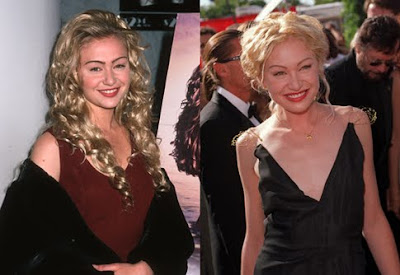Portia De Rossi was my thinspo crush. For those of you unacquainted with the ’90s, before she was Ellen Degeneres’ wife she was on a little show called Ally McBeal where she starred as a blond super skinny lawyer who liked to sleep around. No, not the main blond super skinny chick – that was Calista Flockhart. No, not the other blond super skinny chick – that was Courtney Thorne-Smith. Noooo, not the other blond super skinny chick – that was Jane Krakowski. The other other other other one, ok? Right, now I’m starting to remember why I hated that show. But while I hated the insipid plot lines and abundance of Barbie locks (seriously, was there even one female brunette on the whole show?), I loved Portia. I wanted to be her. Most importantly, I wanted to look like her. Which is where this came in:

Technically this isn’t the exact pic in my journal – I couldn’t find that one on the Internet, alas Google failed me – but it’s close enough.
Thinspo is a term used mostly by girls with disordered eating – although it is becoming more mainstream these days – to describe a picture, usually of an actress or other super skinny woman, that shows the kind of body you covet. The kind of body you are working for. The kind of body worth starving yourself for. Back in the early hysterical days of the Internet, thinspo sites were everywhere, encouraging readers to pin up the pictures on their refrigerator or in their closet to remind them why they should like that feeling of their stomach turning in on itself and linking to each other in one long daisy chain of jutting hip bones and popping clavicles. You could click from link to link for hours staring at endless pictures of women with unattainable stick figures. And I did.
Being the obedient little disordered eater that I was, I took this thin ideal to heart and tacked up pictures of gorgeous models, actresses and singers and surrounded them with admonitions like “nothing tastes as good as thin feels!!” (so creative, I) and “Do 200 crunches every night before bed! No matter how tired you think you are!!” As the years went on and I imitated Portia’s casual-yet-confident pose in the mirror only to be horrified how my stomach buckled and bulged and the bend where hers lay flat with the only crinkles being from her shirt, I added things like “I hate you!” and “You are ugly and fat and no one will ever love you!” I saw my stomach as failure.
This “thinspiration” journal – heavy on the thin, light on any actual inspiration – stayed with me far longer than I want to admit. But I know I am not alone in this exercise in self-loathing. It isn’t just the eating disordered who tout thinspo as a great get-thin trick. Popular trainers, TV shows and women’s magazines across the board parrot this. These tips run the gamut from telling you to tape a photo of you at your fattest to your refrigerator, to eating naked in front of a mirror, to posting pics of celebs you admire, to hanging the skinny jeans you’re dying to fit into on your closet door, to having pictures of yourself digitally altered to give you a thinner you ideal to strive for. Heck, the entire premise of The Biggest Loser is based on this one concept. All of these things are supposed to inspire you to be better, to stick to your diet, to hone your willpower and perhaps they do work for some people. But all they ever taught me was how I don’t measure up, how I’m not beautiful and why I should hate myself. Even if they did help me put down the candy, it was never out of a feeling of caring or loving for myself but out of punishment and denial. Every time I looked at those pictures I felt worse about myself.

Portia pre-Ally McBeal and post-Ally McBeal
My poster girl Portia was recently on Oprah talking about her new book, Unbearable Lightness, that just came out in which she discusses her long battle with anorexia and bulimia stemming from her days on Ally McBeal. While she’d long been rumored to be anorexic – all the girls on that show were – hearing the words from her own mouth ended up being more wrenching than I had expected. My first reaction was to want to scream at her, “How could you do this to me?! All those years! Wasted! Because I wanted to look like you! Like eating-disordered you! How could you let me think all this time that your standard of beauty was an achievable one?” I wanted to go find her picture (I still have that journal somewhere) and rip it into tiny pieces. I was so so angry at her.
And then I calmed down. Of course my eating disorders were not her fault. They were mine, built choice by choice and honed over many years. And honestly I should have known better; it’s not like Hollywood is known for its meticulous honesty. But the feeling of betrayal is still there. It isn’t that I want her to be silent and unhealthily skinny again. Nor do I want her to be naturally super skinny. I just wanted her to be honest then, when I was so vulnerable and really needed to hear it. But she couldn’t do it then. She lost as much (more, probably) to her eating disorder as I did. So I’m grateful that she can do it now and I applaud her speaking out about it. But it still leaves the issue of thinspo in general.
What do you think about “thinspiration”? Does it motivate you in a positive way to live a healthier life or is it one more way to beat yourself up? Who was your thinspo? Anyone else love to hate the show Ally McBeal??



Pingback:Should We Ban the Phrase “Skinny Fat”? | The Great Fitness Experiment
Pingback:Should We Ban the Phrase “Skinny Fat”? |
Pingback:Anorexia Bulimia Care
if i see one more idiotic version of thin-spo i’m leaving the internet for good oh feel sorry for me because i don’t have collar bone’s jutting out from my skin please help me why don’t i have thigh gap i swear with all this going on these brainless idiots think of this